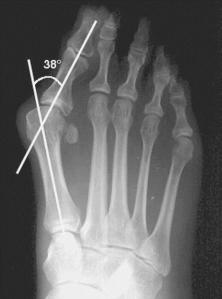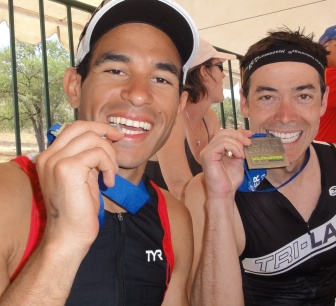I had an athlete the other day ask me if I knew anything about Bunions. Nope. So I asked Louise to inform us all. Happy Reading. Thanks Louise!
What is a Bunion?
Bunions, known medically as Hallux Valgus, are a common, sometimes painful deformity found in the foot. In this condition, the big toe drifts towards the outside of the foot as the metatarsal bone it is attached to angles inward. Associated with the joint migration is a thickening of the inside aspect of the base of the big toe which can be inflammatory and painful. Once the joint angles are altered, muscles and tendons of the foot can no longer support the joint and push off strength is diminished. Because of altered mechanics, the problem is generally progressive.
The x-ray image below demonstrates a moderate bunion deformity at 38 degrees. Severe cases are measured at greater than 40 degrees. The normal angle is 15 degrees or less.
A 2010 systematic review of the scientific literature revealed that approximately 23% of North American adults will develop this problem and the prevalence increases to about 35% after the age of 65. Women are much more likely to be affected by at least three times more often. Frequency of having both feet affected is very high at over 95%. Although not always painful there is a health burden related to bunion development due to costs of corrective surgery, increase of falls in the elderly and increased risk of osteoarthritis.
The cause of bunion joint change is not fully understood and is considered multifactorial. Heredity, older age and being female are the most consistent factors but shapes of joint surfaces, length of foot bones and foot biomechanics are certainly involved in initial onset. Having flexible, hypermobile joints of the foot and a flattened arch also seem to increase the likelihood of bunion development.
Initially footwear choice was thought to be a cause of bunions, particularly high heels and shoes that were narrow or too small. Current research points more to joint anatomy and biomechanical flaws than environmental factors like shoe selection. Walking, jumping or running too much are not causes in themselves but may aggravate the condition and cause more rapid progression.
Soft, supportive shoes with a wide toe box are considered the best option to help manage bunion discomfort. Night splints and cortisone injections are also conservative treatment options. Orthotics have not been shown to prevent progression of the bunion deformity but may help with symptom management. In more painful cases surgical correction is an option.
Unfortunately there is not much to do in the way of prevention of this foot dysfunction. It is one of those afflictions that seem to be mainly genetic and therefore you can reasonably blame them on your parents!
Louise Taylor
Physiotherapist
The DownTownSportsClinics – TD Square
300, 304 8 Ave SW, Calgary AB
403-233-7007







